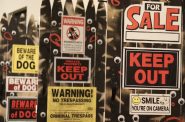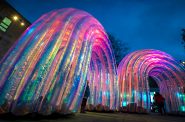A vast China show at the Milwaukee Art Museum
Zhan Wang’s monumental Artificial Rock No. 43 stands like the rocky mountain it represents under the tall spine of Calatrava’s Quadracci Pavilion at the Milwaukee Art Musuem. Wang hammered sheets of steel over two boulders to get their natural shapes, then polished the stainless steel to a gleaming sheen. The reflective surface picks up the colors and moods of Lake Michigan, which lies just beyond the windows.
Wang is a contemporary Chinese sculptor. His steel Artificial Mountain Rocks were the first Chinese contemporary sculptures acquired by the Metropolitan Museum of Art in New York and the De Young Museum in San Francisco, according to Art Speak China.
Rock 43 is the first thing you see of MAM’s sprawling exhibition of Chinese art, which opens Saturday, June 11. The sculpture is in wonderful dialog with The Emperor’s Private Paradise – Treasures from the Forbidden City, the wondrous exhibition of artworks made for the Qianlong emperor in the 18th century.
We enter the Emperor’s Private Paradise through the tall Gateway of the Forbidden City’s Second Courtyard, a rockery. China harbors a long tradition of rock gardens, with sophisticated aesthetics governing the selection, placement and manipulation of rocks. Wang’s Artificial Rock No. 43 addresses this tradition with rockery that Aneesh Kapour could understand, according to Brady Roberts, the Milwaukee Art Museum’s Chief Curator. Roberts chose Wang’s rock to illustrate the contemporary Chinese artists’ deep connection with the past combined with an equally deep understanding of the present art world dialog.
I was fortunate to walk through the Emperor’s Private Paradise exhibition with the elegant Nancy Berliner, Curator of Chinese Art at the Peabody Essex Museum and author of the show’s catalog, and with Laurie Winters, MAM’s Senior Curator and Director of Exhibitions.
Berliner spoke of one large, craggy rock that is visiting Milwaukee. Jagged edges represent the tranquility and longevity of mountains, the ideal place for scholars’ meditations. This specimen is about three feet tall and set on a pedestal. Berliner noted that some rockeries in the Forbidden Garden are over two stories tall. The rockeries in the garden comprise Lingbi rocks, chosen for three qualities: penetrability (see into an opening), wrinkling (faceted surface) and “awkwardness.” Berliner described them as “anti-aesthetic” and purposely not meant for that “childish appreciation” of something merely pretty. She likened it to the anti-aesthetic of Abstract Expressionism, pointing out the rock’s surface “wrinkled like a de Kooning sculpture.”
A large portrait of the Qianlong emperor hangs near the rockery. This portrait appears at first to be a very traditional Chinese painting on silk, with the emperor’s dragon symbols and imperial yellow. But something is different. The face is modeled with delicate shadows and the patterned carpet recedes in perfect linear perspective. Berliner explained that the emperor was very interested in western art and culture. Jesuit missionary artists taught the Chinese perspective and illusion of form. As we walked through this collection of more than 90 objects from the Qianlong Garden, she pointed out over and over the instances of Western influence within the Chinese murals, screens, furniture, jades and cloisonné.
The Forbidden City was the emperor’s winter palace, and the theme of Three Friends of Winter — bamboo, pine, and prunus (winter-blooming plum blossoms) — recur frequently. This theme is a motif in classical Confucian texts, art and poetry. Pine and bamboo stay green throughout the cold of winter. Plum trees bloom around the Chinese New Year. For the emperor, they symbolized virtuous people’s ability to flourish despite adversity.
The Three Friends of Winter are a good symbol for the Qianlong Emperor, who brought great prosperity to China. The population of China tripled from that of his grandfather’s reign. His openness to Western culture helped feed this population with corn and sweet potatoes, which are easier to grow than rice.
The emperor commissioned most of the pieces in the show, and most of them were made on the grounds by staff artisans. But one of the most amazing pieces, a room-dividing screen, was a gift from a party unknown. The screen comprises 16 double-sided panels, each 84 x 28 x 2 ½ inches. We approach this screen from the back side. The panels are carved from zitan, a very hard, dark wood, with delicately patterned flora from across the domain painted in pale cream-colored lacquer and gold.
It turns out that this side of the screen was built into a niche and thus pristinely preserved. Its perfect condition guided the conservators who restored the other side.
The front of the screen holds very different imagery. Each panel shows one of the luohan (enlightened ones), the 16 disciples of Buddha. They are depicted in the traditional way, as grotesques. The instructive point is that one should focus on enlightenment, inner beauty, not external prettiness. The Qianlong emperor, who wrote more than 42,000 poems, added comments to each, such as “Ugly creature known for his good will.”
The Qianlong Emperor wanted a place to cultivate his mind and contemplate the ideal of great peace and prosperity within a Confucian tradition. This show presents many objects and subjects that facilitate the required calm. The Chinese garden favors mountains and water, beauty and spaces for contemplation. The emperor certainly wrote some of his poems, in his beautiful calligraphic style, at a smooth stone garden table with carved marble stools. Tall paintings on silk depict his wife and children and many of the objects on view in the same room of the MAM exhibition.
In the garden, the emperor favored contemplative austerity. Indoors, luxury abounded. A jade rockery boulder stands stands near intricately carved jade urns. Furniture tends to be in rare woods imported to China and carved exquisitely and inlaid with patterns of bamboo. To walk through this exhibition is to experience the emperor’s frame of mind. The Qianlong Emperor honored tradition, oversaw the artistic production, and encouraged an open mind to western cultures.
China’s Palace Museum has shared this large exhibition with three art museums in the United States. The Milwaukee Art Museum is its last stop before returning to China. Since 2001, many objects in this exhibition have been faithfully restored through cooperation of the Palace Museum in Beijing and the World Monuments Fund. The WMF is the leading private international historic preservation organization. Since 1965 it has worked to save more than 600 historic sites in over 90 countries around the world. The WMF’s work includes providing financial support, technical assistance, advocacy, and education.
Also on view during this Milwaukee Art Museum Summer of China: Warriors, Beasts and Spirits: Early Chinese Art from the James Conley Collection; and Emerald Mountains: Modern Chinese Ink Paintings from the Chu-tsing Li Collection. Way of the Dragon: The Chinoiserie Style, 1710-1830, will open June 30.
Together, these shows offer Milwaukee unprecedented access to a wide range of art from and inspired by China. These shows are not to be missed, but some people have protested and suggested a boycott. The reason, of course, is the outrageous imprisonment of Ai Weiwei, one of China’s most famous artists. He has been imprisoned since early April for his critiques of the totalitarian Chinese regime. Milwaukee Art Museum Director Dan Keegan believes that the mission of the museum is to present art, educate, and to engage the people in Milwaukee. The art museum should act as a forum for discussion and education. It shouldn’t be taking stands on political points or leading protests.
I completely agree. The Milwaukee Art Museum has been working on the Emperor’s Private Paradise for over three years. See this exhibition. Learn about Chinese culture and enjoy the beauty and the content of Chinese art. Know that the museum has brought in contemporary Chinese artists to broaden the experience. In fact, the art museum tried to get one of Ai Weiwei’s sculpture installations, even before his imprisonment, as I understand it, but was not able to secure the loan Zodiac Heads, figures from the Chinese zodiac which are a re-creation of a commission by the Qianlong Emperor.
Boycotting or protesting this exhibition would not help Ai Weiwei. But MAM is adding a little sting to its Summer of China. On July 7, the museum will host a panel discussion entitled Ai Weiwei: The Collision of Art and Politics, as one of many programs associated with these shows. That’s how to remind the Chinese government that the whole world, including Milwaukee, is watching.
Lee Ann Garrison is a painter, a professor of art at UWM and chair of UWM’s Department of Art and Design.
Art
-
Winning Artists Works on Display
 May 30th, 2024 by Annie Raab
May 30th, 2024 by Annie Raab
-
5 Huge Rainbow Arcs Coming To Downtown
 Apr 29th, 2024 by Jeramey Jannene
Apr 29th, 2024 by Jeramey Jannene
-
Exhibit Tells Story of Vietnam War Resistors in the Military
 Mar 29th, 2024 by Bill Christofferson
Mar 29th, 2024 by Bill Christofferson


























This rocks Ms. Garrison!
To take advantage of this great China show at MAM, Chinese Culture Fest will be held at MAM, on July 23-24. One ticket ($10 before July 17, $14 after, Children at age 12 or under free with an adult) for Chinese Culture Fest gives you a free access to the big China show at MAM. Chinese Culture Fest will include many Chinese cultural activities, performances, authentic Chinese food, Oriental marketplace and more. The highlight of the festival will be the Dragon Boat Race – vibrant colored boats filled with men and women vigorously paddling, racing to cross the finish line first. Not only will the visuals be pure excitement, but the sounds of the pounding drum on each boat and the thumping of water as the oars power toward the finish will be symphonic. Please visit us at http://www.chineseculturefest.org/ for more information and send emails to ccfmke@gmail.com if you have more questions.
See you at Chinese Culture Fest in Milwaukee on July 23-24.
Great job, Profess Garrison!
To take advantage of this great China show at MAM, Chinese Culture Fest will be held at MAM, on July 23-24. One ticket ($10 before July 17, $14 after, Children at age 12 or under free with an adult) for Chinese Culture Fest gives you a free access to the big China show at MAM. Chinese Culture Fest will include many Chinese cultural activities, performances, authentic Chinese food, Oriental marketplace and more. The highlight of the festival will be the Dragon Boat Race – vibrant colored boats filled with men and women vigorously paddling, racing to cross the finish line first. Not only will the visuals be pure excitement, but the sounds of the pounding drum on each boat and the thumping of water as the oars power toward the finish will be symphonic. Please visit us at http://www.chineseculturefest.org/ for more information and send emails to ccfmke@gmail.com if you have more questions.
See you at Chinese Culture Fest in Milwaukee on July 23-24.
[…] City is garnering much acclaim from the press. Check out with the Milwaukee Journal Sentinel, Third Coast Digest, and the Business Journal had to say about […]
[…] ThirdCoast Digest […]